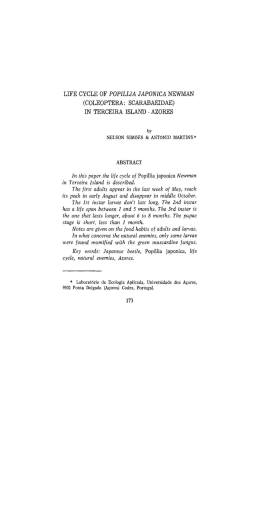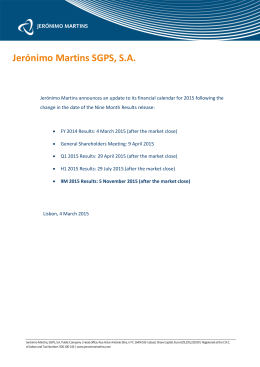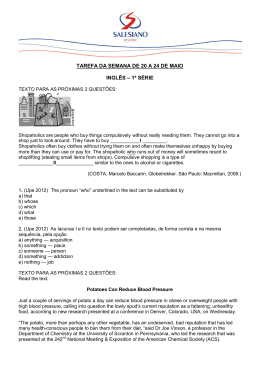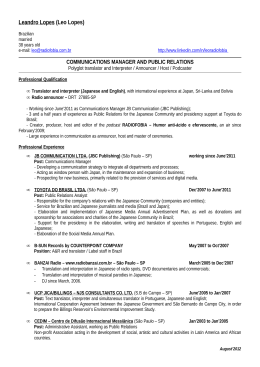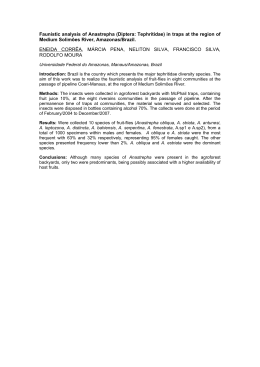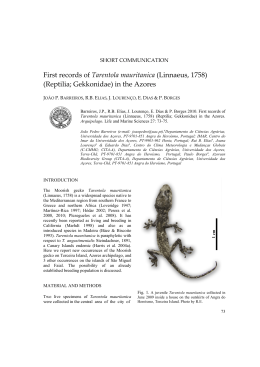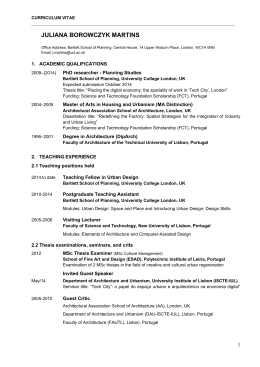POPULATION DYNAMICS O F THE JAPANESE BEETLE (COLEOPTERA: SCARABAEIDAE) I N TERCEIRA ISLAND - AZORES by ANT6NIO MARTINS & NELSON SIMOES* ABSTRACT Since its introduction in Terceira Island in the early 70fs, the Japanese beetle (Popillia japonica Newman) has been spreading out from its initial focus of infestation, to the interior agricultural areas of the island, through more favourable zones to its establishment. The data found in the survey trapping, in 1983 and 1984, show an irtcreasing population throughout the area occupied by the pest (2.1 fold). On the other hand, the estimation of the larvae population, in February of 1984 and 1985, allows the prediction of an increase of about 6 times fold in the adult population for the year of 1985. Key words: Japanese beetle, Popillia japmica, population dynamics, Azores. Laborat6rio de Ecdogia Aplicada, Universidade dos A~ores, 9502 Ponta Delgada (Agwes) Codex, Portugal. I* ANTONIO MARTINS & NELSON SIMCIES 0 escaravelho japon&, Popillia japonica Newman, foi introduzido na Ilha Terceira, no infcio da dicada de 70. Desde entdo, a popula~dotern vindo a aumentar e a dispersar-se pela drea de pastagem. As capturas de adultos e m 1983 e 1984 mostram que a popula@o aumentou 2,l vezes, de urn ano para o outro. A estimativa da popula@o larvar aponta para u m crescimento de cerca de 6 vezes, de 1984 para 1985. Termos chave: Escaravelho japon&s, Popillia japonica, dindmica populational, Agores. The Japanese beetle, Popillia japonica Newman, was first f m d in Terceira Island (Azores) in the early 70's, feeding in the officer's gardens of the United States Air Force Base (Lajes). Probably it was introduced from the United States by military aircrafts. Initially the infestation was restricted to the Air Base fields and erradication measures were undertaken, namely, chlordane spraying plus trapping. Nevertheless, these proved to be insufficient to prevent dissemination of the pest. The beetle population increased and spread crut of the Air Base (SIMOES & MARTINS, in press). Since 1974, the portuguese agricultural authorities carried out survey trapping off Base. The traps placed surrounding the air field caught the maximum number of beetles in 1976 and 1977. During the summers of 1977 and 1978, the local Department of Agriculture made aerial spraying with carbaryl, over the most affected areas, around the Base. Survey trapping was carried on with just a few bait traps. In 1977 and 1978, after the spraying with carbaryl, there was a considerable drop on the number of adults caught (A. CARVAO, pers. comm.). POPULATIOsN DYNAMICS O F THE JAPANESE BEETLE Although the number of catches in the traps surrounding the air field shows to be stationary since 1978, a spreading of the pest to the interior agricultural areas of the island, through more favourable zones to its establishment, has been observed. In 1983, the infested area covered a strip of about 8 km, centered at the Air Base and, in the survey trapping, some 25,000 ins8ectswere captured, irregularly distributed throughout the infested area. The data found allowed the establishment of 3 zones with different degree of infestation (figure 1). A zone with maximum infestation (A), where 19 p. 100 of the traps caught 80 p. 100 of the whole beetles; a zone with medium infestation (B), where 21 p. 100 of the traps caught 5 p. 100 of the beetles; and, a zone with small idestation (C), where 60 p. 100 of the traps just caught 6 p. 100 of the total beetles (table 1). In 1984, the number of catches increased 2.1 times (some 52,000 beetles were captured). Although the number of insects caught per trap increased all through the infested area, the rise was more dear in the zone with medium idestation (2.3 fold). In .the other 2 zones, the number of catches only increased about 1.5 (table 1). In order to estimate the larvae populations in each of the 3 zones with different adult densities, the immature stages of the beetle were sampled in soil, according to FLEMING .& BAKER (1936), in February of 1984 and 1985. The larvae densities estimated show a close relation with the data of the preceding survey trapping season. As we can see in table 2, there was a a ~increase in the larval densities, in all the 3 zones considered, and that it was significantly greater in the zone with medium infestation. ANT6NIO MARTINS & NELSON SIYdES Japanese beetle trapping data in Terceira Island in the 3 zones of 'different infestation in 1983 and 1984. Dados das capturas de escaravelho japonis nu Ilha Terceira, nas 3 zonas de diferente infesta~iio,em 1983 e 1984. Traps Zme Adults I Traps 1 - - Advlts I% A B C 19 21 60 TABLE 2 Grub surveys vf Japanese beetle in Terceira Island in the 3 zones af diikrent infestatim in 1984 and 1985. h o s t r a g e m lamares de P . japonica nu Ilha Terceira, nas 3 zonas de diferente infesta~iio,em 1984 e 1985. I N , l l ~ l l kof larvae per unit area sampled (0.09 m2) POPULATION DYNADdICS OF THE JAPANESE BEETLE The results show that the population of P. japonica in the initial core begun to decrease and that, simultaneously, an increasing colonization occured to the inner part of the island, above the 200 meters. The actual core of infestation is located 6 km away from the initial one, occupying an area of about 1170 ha. " REFERENCES CITED FLEMING, W. E., F. E. BAKER, 1936. A method for estimating populations of larvae of the Japanese beetle in the field. J. Agri. Res, 53, 319-331. SIMOES, N., A. MARTINS. Preliminary note on the infestation of Popillia japonica Newman (Coleoptera: Scarabaeidae) in Terwira Island -Azores (in press). * The present work was supported by the Regional Direct00 for Agriculture (D.R. A., Azores).
Download
